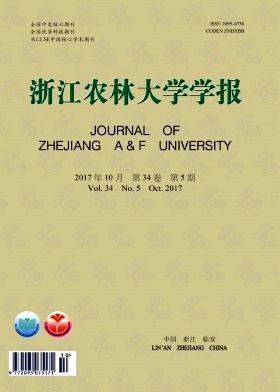-
竹子具有繁殖快、产量高、用途广等优点,已经成为最重要的非木生物质资源。竹子资源的开发利用研究吸引了众多关注。课题组对竹材的秆形结构[1]、解剖构造[2]、物理力学[3]、化学成分[4]、板材利用[5-9]、生物质液化[4, 10]等进行了系统性研究,发现竹材的解剖构造、物理力学性质是影响竹板材性能的重要因素[7-8]。竹材的物理力学性质不仅区别于竹种之间[11],也随竹龄与竹秆高度的变化而发生变异[3, 12-13]。物理力学性质随竹龄的变异体现了竹材的成熟过程,未成熟或过成熟都会削弱竹材的使用价值。竹材物理力学性质随竹秆高度的变异直接影响着竹材的加工方式以及利用率,通常情况下,竹壁较厚的竹秆中、下部位利用较多,而竹壁较薄的竹秆梢部利用较少。硬头黄竹Bambusa rigida为禾本科Gramineae簕竹属Bambusa植物,是四川地区除慈竹Neosinocalamus affinis外的第二大丛生竹种。硬头黄竹秆基部竹壁厚、节间短、硬度大,是制作农耕用具的理想材料。硬头黄竹与毛竹不同,为每年发笋成竹,作为板材加工的原料,如何选择物理力学性质稳定的竹龄伐竹已成为人们关注的焦点。目前,虽有关于硬头黄竹物理力学性质的研究,但其局限于3年生竹材的物理力学性质的轴向变异研究,未涉及竹龄对竹材材性的影响评估[14]。因此,不同竹龄硬头黄竹材性的研究空白亟待填补。本课题组已报道了硬头黄竹的解剖性质[15]与耐老化性质[16-17]的相关研究成果。在本研究中,笔者对四川宜宾产竹龄为0.5~4.5 a的硬头黄竹竹材物理力学性质进行了系统研究,以期为其择林伐竹提供理论参考。
HTML
-
供试硬头黄竹采自四川省宜宾市长宁县,28°15′~28°47′N,104°44′~105°03′E,属亚热带湿润性季风气候,无霜期长,雨热同季,年均气温为18.3 ℃,年均降水量为1 114.2 mm,年日照时数为1 148.0 h,无霜期平均>350 d。试材采集于2014年2月,此阶段竹材淀粉含量最低。竹材年龄判定由当地有经验林主通过竹鞘与竹秆颜色的甄别而实现。选取竹龄为0.5~4.5 a,生长良好、无病虫害的样竹各10株,齐地伐倒,断面蜡封,全秆运回实验室。自秆基至秆梢,3 m 1段,分别标记为基部、中部、梢部。由于秆高9 m以上竹秆直径(≤2.6 cm)与壁厚(≤3.10 mm)较薄,不易加工为标准试件,遂放弃对其测试。
-
竹材物理性质的试材规格与测试方法参照GB/T 15780-1995《竹材物理力学性质试验方法》[18]。物理性质测定试样均未去除竹青与竹黄。测定指标包括生材含水率、基本密度、体积干缩率,试样尺寸均为10 mm × 10 mm × t mm(竹壁厚)。竹材伐倒后立即取样称量记录,而后置于电热干燥箱中烘干(103±2)℃)至恒量,以测定竹材生材含水率。试验重复30次·组-1。
-
竹材力学性质测定试样均为未去除竹青与竹黄的原竹竹材。竹材顺纹抗压强度(compression strength parallel to grain, CS)和顺纹抗剪强(shear strength parallel to grain, SS)的试材规格及测试方法度参照GB/T 15780-1995《竹材物理力学性质试验方法》[18],加压速度恒定为0.5 mm·min-1,直到压力达到最大值或试件破坏为止,试件尺寸分别为20 mm × 20 mm × t mm(竹壁厚),35 mm × 20 mm × t mm(竹壁厚)。抗弯强度(modulus of rupture, MOR)与抗弯弹性模量(modulus of elasticity, MOE)的试材规格及测试方法参照TRAN[19]所述方法进行测定。弯曲试验的试件尺寸为200 mm × 12 mm × t mm(竹壁厚),跨距为150 mm,沿竹壁径向加压,加压速度为10 mm·min-1。试验重复30次·组-1。
-
文中数据统计由Excel 2007实现,单因素方差分析与Tukey多重比较由SPSS 17.0实现。
1.1. 材料
1.2. 方法
1.2.1. 竹材物理性质的测定
1.2.2. 竹材力学性质的测定
1.2.3. 数据统计与分析
-
原竹交易多以质量计算,生材含水率是影响竹材价格的重要因素。因此,生材含水率是竹材交易的重要参考指标。如表 1所示:竹龄为0.5 a竹材的生材含水率最大(196.30%~227.06%),1.5 a的竹材次之(63.93%~104.13%),3.5~4.5 a时基本达到稳定(44.06%~76.45%)。Tukey多重比较显示,竹龄0.5 a的竹材的生材含水率显著高于其他竹龄竹材(P<0.05)。自秆基至秆梢,竹材生材含水率呈下降趋势。竹材生材含水率随竹龄及竹秆部位的变异与竹材解剖结构及化学成分的变化有关[20-21]。竹龄0.5 a的硬头黄竹细胞壁薄,细胞腔径大[15],可容纳自由水的空间大,含水率高。随竹龄的增加,纤维细胞逐年增厚[15, 22-23],细胞腔径减小,含水率下降。随秆高的增加,硬头黄竹纤维细胞、薄壁细胞及导管的腔径减小[15],竹材孔隙度降低,容水能力下降。
竹秆部位与均值 竹龄/a 含水率/% 基部 0.5 227.06±13.23 a 1.5 104.13±10.14 b 2.5 90.99±9.54 b 3.5 76.45±7.52 b 4.5 73.99±8.31 b 中部 0.5 203.37±11.35 a 1.5 75.18±8.19 b 2.5 64.42±6.87 b 3.5 60.29±5.97 b 4.5 58.82±6.84 b 梢部 0.5 196.30±12.77 a 1.5 63.93±6.17 b 2.5 47.99±57.03 b 3.5 45.27±5.01 b 4.5 44.06±4.13 b 均值 0.5 208.91±16.11 a 1.5 81.08±20.74 b 2.5 67.80±21.70 b 3.5 60.67±15.59 b 4.5 58.95±14.97 b 说明:同列字母相同者表示数据在0.05水平差异不显著。 Table 1. Moisture content of green Bambusa rigida at different bamboo ages
-
基本密度是竹材重要的物理性质,它与竹材力学强度、吸水性密切相关,其大小取决于竹材解剖结构及化学成分,是衡量竹材材性的重要指标[24]。如表 2所示:竹龄为0.5~1.5 a,竹材基本密度的增幅为91.67%,达显著水平(P<0.05),而后逐年平稳增加。虽然竹龄0.5 a的竹材结束了高生长期,细胞长度伸长完成,但细胞壁仍发育不成熟,竹材基本密度较小。高生长期结束后,竹材进入材质成熟阶段,竹材的淀粉积累及细胞壁厚逐渐增大,有机物积累增加[20-21, 25],此阶段可长达12.0 a[22]。硬头黄竹解剖性质研究发现:竹龄0.5~2.5 a,硬头黄竹纤维细胞及薄壁细胞壁厚显著增大,而后纤维细胞及薄壁细胞壁厚增幅较小[15]。随秆高的增加,硬头黄竹竹材基本密度逐渐增大。竹秆高度增加,竹壁厚度减小,竹材维管束密度增大,纤维组织比量增加,因而竹材密度增加[20]。硬头黄竹竹材基本密度随竹秆高度的变异规律与慈竹类似[3]。
竹秆部位与均值 竹龄/a 基本密度/(g·cm-3) 基部 0.5 0.35±0.02 a 1.5 0.59±0.04 b 2.5 0.58±0.03 b 3.5 0.62±0.02 b 4.5 0.66±0.04 b 中部 0.5 0.36±0.01 a 1.5 0.69±0.02 b 2.5 0.69±0.03 b 3.5 0.71±0.04 b 4.5 0.74±0.01 b 梢部 0.5 0.37±0.01 a 1.5 0.79±0.07 b 2.5 0.81±0.06 b 3.5 0.83±0.02 b 4.5 0.83±0.11 b 均值 0.5 0.36±0.01 a 1.5 0.69±0.10 b 2.5 0.70±0.10 b 3.5 0.72±0.10 b 4.5 0.75±0.10 b 说明:同列字母相同者表示数据在0.05水平差异不显著。 Table 2. Variation in basic density of Bambusa rigida with respect to bamboo ages
竹材的干缩率是影响竹制品质量的重要因素。表 3显示:随竹龄的增加,硬头黄竹体积干缩率逐渐减小,其规律类似于慈竹[3]、大木竹Bambusa wenchouensis[26]。Tukey多重比较表明,竹龄0.5 a的硬头黄竹体积干缩率与其他竹龄竹材间差异显著。竹龄越大,竹材木质化程度越高,细胞强度越大,从而竹材稳定性越高[21]。自秆基至秆梢,竹材体积干缩率逐渐减小,与KAMRUZZAMAN等[13]研究结果类似,这可能与维管束密度沿轴向增加有关[20]。
竹秆部位与均值 竹龄/a 体积干缩率/% 基部 0.5 35.81±1.30 a 1.5 16.21±0.42 b 2.5 15.77±1.83 b 3.5 14.90±1.20 b 4.5 11.76±1.91 b 中部 0.5 33.95±1.32 a 1.5 14.14±0.54 b 2.5 14.64±0.30 b 3.5 13.43±1.84 b 4.5 11.01±0.62 b 梢部 0.5 30.76±1.56 a 1.5 11.96±0.56 b 2.5 11.26±1.58 b 3.5 9.29±0.45 b 4.5 8.87±0.81 b 均值 0.5 33.51±2.56 a 1.5 14.10±2.77 b 2.5 13.83±2.48 b 3.5 12.54±2.74 b 4.5 10.50±1.49 b 说明:同列字母相同者表示数据在0.05水平差异不显著。 Table 3. Volumetric shrinkage of Bambusa rigida as a function of bamboo ages
-
竹材的顺纹抗压强度指竹材沿着纹理方向承受压力荷载的最大能力,反应细胞轴向支撑力,是竹材力学性质中最重要的特征之一,由竹材的微观构造所决定[27]。随竹龄的增加,硬头黄竹顺纹抗压强度逐渐增大(表 4)。Tukey多重比较发现:竹龄0.5~1.5 a时,竹材的顺纹抗压强度显著增大,达60.38%,而后增幅减小,3.5 a时达到最大(82.41 MPa)。虽然竹龄0.5 a的竹材完成高生长,但纤维细胞仍未成熟,轴向支撑力弱,高生长结束后,竹材纤维细胞壁厚显著增加[15],轴向支撑力显著增大。竹龄达4.5 a时,顺纹抗压强度略有降低,这与竹材的过成熟化引起的材质老化有关[21]。
竹秆部位与均值 竹龄/a 顺纹抗压强度/MPa 基部 0.5 46.37±2.37 a 1.5 67.91±3.62 b 2.5 71.93±7.04 b 3.5 73.34±6.06 b 4.5 73.91±5.31 b 中部 0.5 46.38±1.92 a 1.5 72.20±3.61 b 2.5 81.52±2.57 b 3.5 84.45±2.30 b 4.5 81.97±3.27 b 梢部 0.5 44.81±2.98 a 1.5 79.40±2.61 b 2.5 89.13±5.00 b 3.5 90.34±2.62 b 4.5 90.72±6.29 b 均值 0.5 45.86±0.91 a 1.5 73.55±5.73 b 2.5 80.86±8.62 b 3.5 82.41±8.55 b 4.5 82.20±8.41 b 说明:同列字母相同者表示数据在0.05水平差异不显著。 Table 4. Compression strength parallel to grain of Bambusa rigida at different bamboo ages
竹龄0.5~1.5 a间竹材顺纹抗剪强度显著增大,达43.41%(表 5)。竹龄达2.5 a后,竹材顺纹抗剪强度维持在12.0 MPa左右。竹秆轴向上,竹龄0.5 a的竹材梢部顺纹抗压及抗剪强度小于中部与基部,原因可能是竹子梢部的成熟度弱于竹秆中部与基部。竹龄1.5~4.5 a的竹材顺纹抗压强度及1.5~3.5 a的竹材顺纹抗剪强度随秆高的增加逐渐增大。维管束密度随秆高的增加是促使力学性质沿秆高增大的重要因素[20]。竹龄4.5 a的竹材顺纹抗剪强度由竹秆中部到梢部呈减小趋势,可能是因为竹龄4.5 a的竹秆梢部木质化程度过高,细胞脆性增大,材质老化[21]。
竹秆部位与均值 竹龄/a 顺纹抗剪强度/MPa 基部 0.5 8.41±0.12 a 1.5 10.11±0.24 b 2.5 10.46±0.51 b 3.5 10.66±1.07 b 4.5 11.09±1.75 b 中部 0.5 8.15±0.35 a 1.5 11.84±0.93 b 2.5 12.42±0.97 b 3.5 12.52±0.79 b 4.5 13.48±1.08 b 梢部 0.5 7.56±1.65 a 1.5 12.64±0.48 b 2.5 13.07±1.31 b 3.5 12.78±0.98 b 4.5 11.49±1.94 b 均值 0.5 8.04±0.44 a 1.5 11.53±1.24 b 2.5 11.98±1.35 b 3.5 11.99±1.31 b 4.5 12.02±1.28 b 说明:同列字母相同者表示数据在0.05水平差异不显著。 Table 5. Shear strength parallel to grain of Bambusa rigida with respect to bamboo ages
-
硬头黄竹抗弯强度如表 6所示。竹龄3.5 a的硬头黄竹抗弯强度(MOR)最大,达237.13 MPa,4.5 a次之(215.50 MPa),0.5 a最小(151.42 MPa)。竹龄3.5 a的硬头黄竹抗弯弹性模量(MOE)最大,达18.32 GPa,4.5 a时下降到15.30 GPa(表 7)。竹龄0.5 a的竹材未成熟,抗弯强度小,而后,纤维细胞壁厚显著增加[15],基本密度增大,抗弯强度与抗弯弹性模量显著增大。竹龄4.5 a的竹材细胞壁木质化程度高,竹材脆性大,抗弯强度下降[21],尤其秆梢处抗弯性能下降明显(抗弯强度降低达9.12%,抗弯弹性模量减小达16.48%)。随秆高的增加,竹龄0.5~3.5 a的竹材抗弯强度、抗弯弹性模量逐渐增大,变异规律与NORDAHLIA等[12]和KAMRUZZAMAN等[13]的研究结果吻合。竹材抗弯性质随竹秆轴向的变异与维管束密度沿轴向变异有关,维管束密度越大,竹材抗弯强度及抗弯弹性模量越大[20]。然而,竹龄4.5 a的竹秆的抗弯强度及抗弯弹性模量在秆梢处出现了减小,可能由竹秆老化造成[21]。
竹秆部位与均值 竹龄/a 抗弯强度/MPa 基部 0.5 128.62 ± 23.48 a 1.5 153.26±13.37 b 2.5 186.61 ± 14.30 ab 3.5 191.46 ± 20.31 b 4.5 180.44 ± 39.87 ab 中部 0.5 138.10 ± 12.42 a 1.5 204.01 ± 1.73 b 2.5 216.13 ± 2.73 ab 3.5 242.07 ± 19.07 b 4.5 240.17 ± 14.50 b 梢部 0.5 187.54 ± 9.90 a 1.5 208.94 ± 4.29 b 2.5 221.13 ± 5.68 b 3.5 277.86 ± 14.95 c 4.5 223.95 ± 33.71 b 均值 0.5 151.42 ± 31.63 a 1.5 188.74 ± 27.31 b 2.5 207.95 ± 17.88 bc 3.5 237.13 ± 43.41 c 4.5 215.50 ± 31.47 bc 说明:同列字母相同者表示数据在0.05水平差异不显著。 Table 6. Modulus of rupture (MOR) of Bambusa rigida at different bamboo ages
竹秆部位与均值 竹龄/a 抗弯弹性模/GPa 基部 0.5 10.84±1.73 a 1.5 12.47±2.00 a 2.5 15.50±1.09 b 3.5 15.97±2.14 b 4.5 15.73±1.76 b 中部 0.5 12.46 ± 0.62 a 1.5 15.32±1.02 b 2.5 17.70 ± 1.19 bc 3.5 19.19 ± 1.01 c 4.5 16.60 ± 1.96 b 梢部 0.5 16.41 ± 1.08 ab 1.5 16.54 ± 0.84 ab 2.5 18.35 ± 1.16 bc 3.5 19.82 ± 1.22 c 4.5 13.57 ± 1.88 a 均值 0.5 13.24 ± 1.90 a 1.5 14.95 ± 2.15 a 2.5 17.18 ± 1.49 b 3.5 18.32 ± 2.90 b 4.5 15.30 ± 1.56 a 说明:同列字母相同者表示数据在0.05水平差异不显著。 Table 7. Modulus of elasticity (MOE) of Bambusa rigida as a function of bamboo ages
2.1. 生材含水率
2.2. 基本密度与体积干缩率
2.3. 顺纹抗压强度及顺纹抗剪强度
2.4. 抗弯强度及抗弯弹性模量
-
随竹秆高度的增加,竹龄0.5~3.5 a的硬头黄竹,生材含水率与体积干缩率逐渐降低,基本密度、顺纹抗压强度、顺纹抗剪强度、抗弯强度及抗弯弹性模量逐渐增大。竹龄4.5 a的竹材梢部出现老化现象,造成顺纹抗剪强度、抗弯强度及抗弯弹性模量的降低。竹龄3.5 a的硬头黄竹生材含水率、基本密度、体积干缩率、顺纹抗剪强度基本达到稳定,顺纹抗压强度、抗弯强度及抗弯弹性模量达到最大。因此,竹龄为3.5 a的生长期可作为硬头黄竹的伐竹年龄参考。






 DownLoad:
DownLoad: